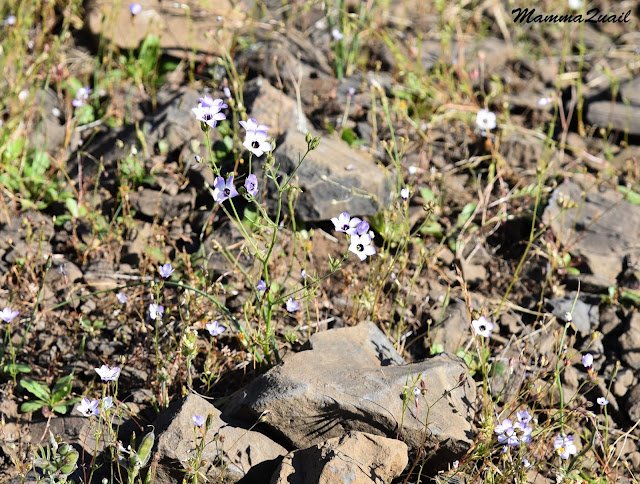Date: March 31, 2018
Place: Jack London State Historic Park, Glen Allen, California
Address: 2400 London Ranch Rd. Glen Allen, Ca, 95442
Length: 5 miles
Level: Moderate
 |
| Our hike as captured by Pappa Quail's GPS |
In my youth I read an entrancing book about a Californian dog that was kidnapped to serve as a sleigh dog for gold rush miners in Alaska, where he eventually turns wild and joins the wolves. Although I read other books by its author, Call of the Wild remains until today my favorite book by Jack London.
When I moved to California it didn't take me long to find out that Jack London's origin was in the Bay Area. He grew up in Oakland but had left his mark in many places around the Bay before becoming a world traveler and renowned reporter and novelist. In one of my earlier visits to Sonoma County I also discovered that he had a ranch there where he lived with his wife the last 5 years of his life, where now is the Jack London State Historic Park.
On that first visit there with my family I saw the historic buildings and ruins, and visited Jack London's grave. We couldn't stay long that time, though, and I left with a feeling that I didn't see as much as I'd liked to have seen of this park. It took me nearly 12 years to return there.
 |
| At the trailhead |
We left home late on Saturday morning and I set the navigator to Jack London Park. When we arrived there it was already afternoon and we started down the trail thinking of having a nice, short hike before moving on to Arcata, where I have booked us lodging for that night.
 |
| Blue-eyed Grass, Sisyrinchium bellum, near the trailhead. |
 |
| Sky Lupine, Lupinus nanus |
Old farm buildings are scattered around the historic mansion. A tubular tower was visible from the trail that surrounds the vineyard. There was a trail leading there with a sign saying 'Pig Palace'. I was curious to see what's there but the rest of may family were already ahead on the main trail so the Pig Palace was left to the net visit (which I hope will be sooner than 12 years).
 |
| Pig Palace |
Trees generally are at their best in spring time, especially the deciduous tree when coming out of hibernation in a new coat of young leaves.
The evergreen trees are not behind at all - already in bloom, the Pacific Madrone.
 |
| Pacific Madrone, Arbutus menziesii |
 |
| London lake |
 |
| Purple Dead Nettle, Lamium purpureum. Non-native. |
Geranium purpureum. Non-native, invasive.
|
 |
| Lupine, Lupinus sp. |
If I'd have checked how long would be the drive to Arcata after we would have turned around at that place. Is it was, I guessed 2 hours and so we continued on to Fern Lake.
The trail took us through the woods, which were a mix of conifers and broadleaf trees. Most of the way the forest felt deep and dense with a wild feel to it.
 |
| New growth of a young fir |
 |
| Starry False Lily of the Valley, Maianthemum stellatum |
 |
| Canyon Larkspur, Delphinium nudicaule |
 |
| North Asbury Creek |
 |
| Banana Slug |
 |
| California Man-root, Marah fabacea |
 |
| Blackberry, Rubus sp. |
 |
| Fernald's Iris, Iris fernaldii |
 |
| Western Wakerobin, Trillium ovatum |
 |
| The Ancient Tree |
 |
| Fern Lake |
There was some ambiguity about which trail we should take because there were several, trails bracing out at that point. Pappa Quail was ready to start back where we came from but eventually we decided on the right trail that would connect us back with the Vineyard Trail and started the mild ascend back.
 |
| Up the trail from Fern Lake. |
After a short rest we moved on and rejoined the Vineyard Trail. The sun was getting low and the forest darkened.
When we emerged from the trees the trail was completely shaded. The mountain range across the valley was nicely illuminated though. From our angle we could not see the scars of the huge fire that raged in that area only a few months before.
Far across the vineyard was a dead tree, standing still. A turkey vulture was rooting upon it and Pappa Quail photographed it. Then a second vulture swooped by and landed on that tree. Then a third. I asked Pappa Quail to photograph all three but he had already dropped his camera and was striding onward.
I joined Pappa Quail and the chikas on the trail - going back now in the same way we had gone before.
As we approached the old farm buildings I saw a pretty blooming tree that I had missed on the way out. It smelled very nice too. A decorative introduced species - hawthorn.
 |
| Hawthorn, Crataegus monogyne, non-native, invasive |
Just before we completed our hike I checked quickly the expected driving time to Arcata and gulped - the navigation app said four hours. And it was already 5 pm. And there would be a dinner stop. Oops.
Thankfully Pappa Quail didn't push the point too much. There was nothing to do about it anyway, since we had our lodging already reserved for the night. It was a lovely hike at Jack London SHP and since we didn't go into any of the historic buildings or visited his grave this time, I do plan to visit there again. Besides, there are more trails in this park, enough for a few more good hikes.
We arrived at Arcata that night just past 11 pm.

















































